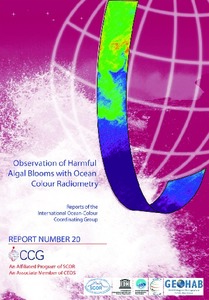| dc.contributor.editor | Bernard, Stewart | |
| dc.contributor.editor | Kudela, Raphael M. | |
| dc.contributor.editor | Robertson Lain, Lisl | |
| dc.contributor.editor | Pitcher, Grant | |
| dc.coverage.spatial | Global | en_US |
| dc.date.accessioned | 2021-04-20T10:54:45Z | |
| dc.date.available | 2021-04-20T10:54:45Z | |
| dc.date.issued | 2021 | |
| dc.identifier.citation | IOCCG (2021) Observation of Harmful Algal Blooms with Ocean Colour Radiometry. (eds. Bernard, S., Kudela,
R., Robertson Lain, L. and Pitcher, G.C.). Dartmouth, NS, Canada, International Ocean-Colour Coordinating Group (IOCCG), 165pp. (Reports of the International Ocean-Colour Coordinating Group, No. 20). DOI: http://dx.doi.org/10.25607/OBP-1042 | en_US |
| dc.identifier.uri | http://hdl.handle.net/11329/1546 | |
| dc.identifier.uri | http://dx.doi.org/10.25607/OBP-1042 | |
| dc.description.abstract | Harmful algal blooms (HABs) and eutrophication events have had a significant global impact over the past few years. The frequency of these events, and the geographic extent of toxic/harmful algal blooms have been increasing globally. For this reason a joint working group was formed between the IOCCG and the GEOHAB Programme (now GlobalHAB) of SCOR and the Intergovernmental Oceanographic Commission (IOC) of UNESCO, tasked with producing a comprehensive guide to satellite ocean colour remote sensing of HABs. The report summarises the state of knowledge and demonstrates the suitability of various ocean colour approaches through case studies from different ecosystems, as well as operational HAB applications. The primary focus areas are the technical difficulties of using ocean colour remote sensing in optically-complex coastal waters, and the need to understand the limitations of ocean colour for deriving phytoplankton community composition. A major conclusion was that ocean colour remote sensing is effective in detecting high biomass blooms, but does not work well for low biomass blooms, which can be addressed using indirect approaches. | en_US |
| dc.language.iso | en | en_US |
| dc.publisher | International Ocean Colour Coordinating Group (IOCCG) | en_US |
| dc.relation.ispartofseries | Reports of the International Ocean Colour Coordinating Group (IOCCG); 20 | |
| dc.rights | Attribution-NonCommercial-NoDerivatives 4.0 International | * |
| dc.rights.uri | http://creativecommons.org/licenses/by-nc-nd/4.0/ | * |
| dc.subject.other | Harmful Algal Blooms | en_US |
| dc.subject.other | GlobalHAB | |
| dc.subject.other | GlobalHAB | |
| dc.title | Observation of Harmful Algal Blooms with Ocean Colour Radiometry. | en_US |
| dc.type | Report | en_US |
| dc.description.status | Published | en_US |
| dc.format.pages | 165pp. | en_US |
| dc.contributor.corpauthor | IOCCG | en_US |
| dc.description.notes | Contributing authors: Stewart Bernard, Mariano Bresciani, Jennifer Cannizzaro, Hongtao Duan, Claudia Giardino, Patricia M. Glibert, Chuanmin Hu, Raphael M. Kudela, Tiit Kutser, Lisl Robertson Lain, Ronghua Ma, Erica Matta, Mark W. Matthews, Frank E. Muller-Karger, Grant C. Pitcher, Suzanne Roy, Blake Schaeffer, Stefan G. H. Simis, Marié E. Smith. Inia M. Soto, Erin Urquhart, Jennifer Wolny | en_US |
| dc.description.refereed | Refereed | en_US |
| dc.publisher.place | Dartmouth, NS, Canada | en_US |
| dc.subject.parameterDiscipline | Parameter Discipline::Biological oceanography | en_US |
| dc.subject.instrumentType | Instrument Type Vocabulary::ocean colour radiometers | en_US |
| dc.subject.dmProcesses | Data Management Practices::Data analysis | en_US |
| dc.description.currentstatus | Current | en_US |
| dc.description.sdg | 14.2 | en_US |
| dc.description.eov | Ocean colour | en_US |
| dc.description.bptype | Best Practice | en_US |
| obps.contact.contactemail | vstuart@ioccg.org | |
| obps.resourceurl.publisher | https://ioccg.org/wp-content/uploads/2021/05/ioccg_report_20-habs-2021-web.pdf | en_US |
 Repository of community practices in Ocean Research, Applications and Data/Information Management
Repository of community practices in Ocean Research, Applications and Data/Information Management

